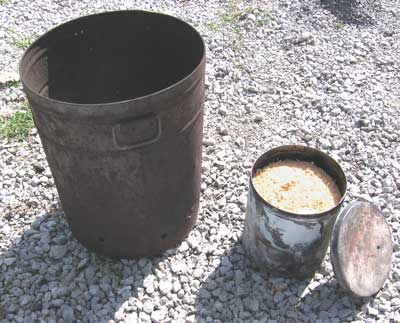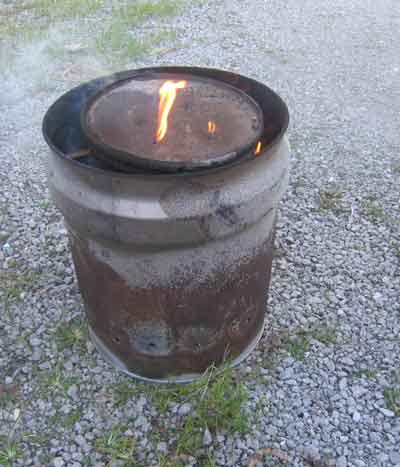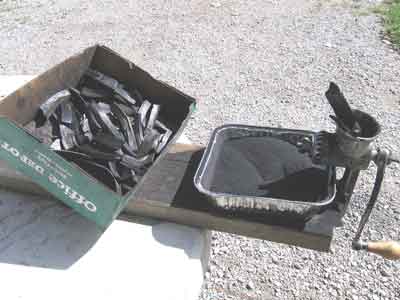| Here's a photo of the setup I use. The container was
not packed tightly and the actual cooking took a little less than an hour.
I use white pine, poplar, or SPF (Spruce-Fir-Pine) available at any lumber yard. Avoid Yellow Pine and wood with a lot of knots due to the amount of sap. The sawdust is freely available from any wood working shop or in my case from cutting my rocket sticks. If you ask a wood working shop, be upfront as to what you want this for and make sure you do not get a mix of hard wood and pine. If you can get sanding dust from the above woods, consider yourself very fortunate! If you have a Feed Supply store near by, check out their animal bedding. You may need to visit the manufacturer's website to find out what kind of wood they use but Aspen and Pine are typical.
There are holes around the bottom of the retort and a brick that the small can rests on. This allows air to flow around the container and helps the charcoal cook evenly. Your fuel can either be charcoal or scrap lumber. |
|
Every tutorial on cooking charcoal is required to have a photo of the escaping gasses burning It's the law.
Please make sure you orient your container properly so the burning gasses do not conflict with each other. Having happy gas is essential to making good charcoal. In this photo, you'll notice the gas jet on the right is about to smite the gas jet on the left. I'm happy to report they settled their differences and lived happily ever after. And no....I did not doctor the photo.
|
|
When little or no smoke comes out, remove the container from the retort and cover the holes to block any air from igniting the charcoal. I drop roofing nails in the holes and the heads cover the vents. Wait an hour or three and open up your can of ready-to-go charcoal. Since you started with small particles of a soft wood, the charcoal is very easy to convert. Putting it in a zip-lock bag and crushing it will yield a good percentage of very fine product. You can also run the finished charcoal through a sieve to remove the larger chunks or mill in a rock tumbler for a few hours.
|
|
I had an empty Perchlorate drum with a banded lid that nested
perfectly inside an empty Eckart Aluminum drum. It seemed only fitting to turn
them onto a charcoal cooker.
|
|
|
|
Sticking a coat hanger in the vent and stirring the sawdust speeds up the process. The same cooking method can be used with chunks of wood but they take longer to cook and require grinding after they cool. Grinding This is the messiest pyro job I know of and only a fool looking for a divorce will attempt it inside the house. Another pyro with more brains than I have suggested putting a plastic bag over the end of the grinder. Hmm..... This meat grinder will reduce the chunks with very little effort. Click on the photo for a better view of the particle size. You can either screen the results ( very messy) or ball mill everything depending on your needs. Where can I find one of these amazing and wonderful grinders? |
|
Update;
|
|
My new setup with a 15 gallon can nested inside a 30 gallon can greatly increased my output. What I didn't consider is that a larger quantity of
charcoal takes a proportionally longer time to cool before you can remove
it from the retort. Below is the result of dumping hot charcoal into a
plastic bucket. Whoops!
|
|
|




